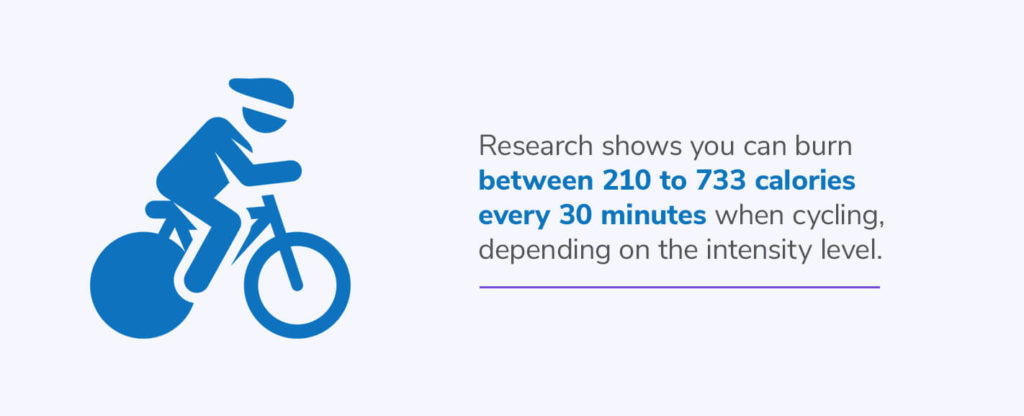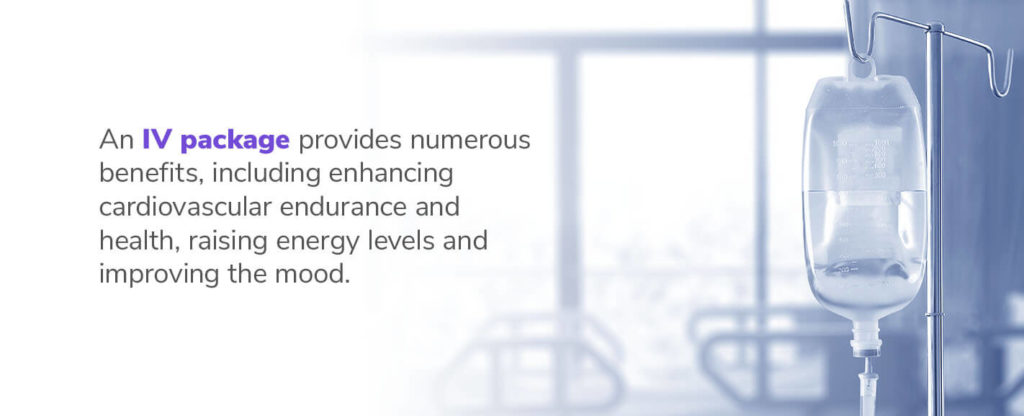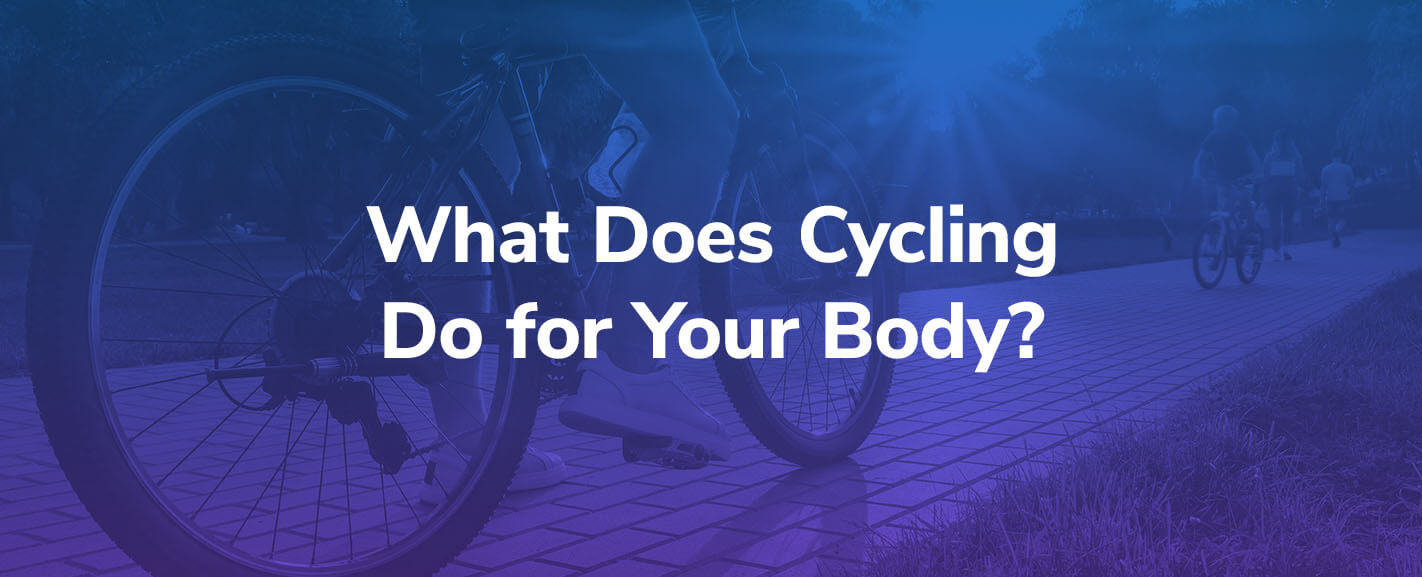Cycling is an aerobic exercise that offers the body numerous benefits. Regular exercise can increase stamina, burn calories, tone muscles and promote overall good health. Cycling is a low-impact exercise, meaning it doesn’t place much strain on the body and is ideal for beginners. Learn what cycling does for your body and the many benefits physical exercise provides.
- The Health Benefits of Cycling
- How Long Do You Need to Cycle?
- Will Cycling Change Your Body Shape?
- What Are the Risks?
- Premium At-Home IV Packages for Rehydration
The Health Benefits of Cycling
Cycling is an excellent way to stay active and exercise without putting excess strain on the joints and body. Cycling is especially beneficial for those new to exercise or who are recovering from an injury. Some of the most well-known cycling benefits include:
1. Aids in Weight Loss
Cycling is an excellent aerobic exercise that can help you burn a significant number of calories and lost weight. Biking is a beginner-friendly option with many intensity levels available to match your fitness skills, helping you elevate your heart rate with less strain on your joints and muscles.
Although running is another beneficial exercise for losing weight, it can place greater strain or stress on the body, especially the joints and ankles. Another benefit of cycling is that it’s enjoyable, so you may not even realize that you’re working out as you do it.
While you can burn a decent number of calories cycling at a calm, leisurely pace, you can burn even more calories when you bike at a higher speed or incline. Higher inclines, speeds and resistance can increase the number of calories you burn because your body needs to use more energy to cycle.

Research shows you can burn between 210 to 733 calories every 30 minutes when cycling, depending on the intensity level. Cycling is also a great way to warm up or cool down following another workout. Incorporating cycling into your workout regularly can help you lose weight and burn excess fat.
2. Improves Mental Health
In general, exercise can improve mental health by reducing stress and anxiety while promoting a general sense of happiness. Cycling helps lower cortisol levels, which is the body’s main stress hormone. Biking can also alleviate tension in your body by getting you active and moving.
Regular exercise can improve emotional and mental health, leading to increased well-being. Exercising, including cycling, can improve alertness, concentration and overall mood. Even small moment moments of exercise can provide noticeable benefits. Any level of exercise is better than remaining inactive.
Cycling helps stimulate the body’s release of positive endorphins, which are the hormones in charge of helping us feel good and happy. These hormones help ease stress and anxiety while promoting an overall sense of happiness and positivity. Staying active and losing weight can also increase confidence, helping you feel better about yourself each day.
Minimizing stress and promoting a healthier, happier mood can also help you sleep better at night because you aren’t kept awake by anxious thoughts. Better sleep can further enhance your mood, providing a restful night of sleep and the energy you need.
3. Helps Prevent Cardiovascular Disease
Cycling may help lower your risk of cardiovascular disease, including heart attack, high blood pressure and stroke. Biking regularly can strengthen the lungs and heart while improving circulation to reduce the risk or potential severity of cardiovascular diseases.
One study showed a connection between biking and a decreased risk of cancer, heart disease and premature death. Heart disease is the leading cause of death among women and men in the United States, with one person dying from cardiovascular disease every 36 seconds.
Frequent exercise is directly related to lowering cardiovascular mortality rates and the overall risk of developing cardiovascular disease in the first place. People who remain physically active often have higher insulin sensitivity, favorable plasma lipoprotein profiles and lower blood pressure.
4. Enhances Circulation
Cycling and regular exercise can improve blood circulation throughout the body. If you experience poor circulation, especially in the legs, cycling can help improve circulation, increasing the heart rate. Biking can also increase the blood volume of the heart.
Circulation is important because it’s essential to help your muscles perform the best they can, and it plays a role in minimizing muscle pains or discomfort while facilitating recovery. Proper circulation also ensures that the organs receive the right amount of nutrients and oxygen to function.
Poor circulation is linked to various cardiovascular complications and diseases that can negatively impact overall health and lead to damage to the brain, heart and kidneys. Poor circulation can also cause the skin of the legs and feet to be more prone to ulceration, infection, injury and delayed healing times.
5. Strengthens Muscles

Another health benefit of cycling is that it can transform the body by strengthening the muscles, notably the hamstrings, quads and calves. Cycling can improve strength and speed, enhance agility and promote muscular toning.
Although the muscles of the lower body are the most engaged, cycling benefits many muscles throughout the body. Cycling can work the abdominal muscles and arms, as well.
Incorporating cycling into your workout routine can burn calories, trim excess fat and improve muscular strength and endurance. Those who cycle regularly often have leaner bodies with toned, stronger muscles.
6. Improves Lung Capacity
When you cycle, your lungs inflate and deflate at a faster rate, pumping harder to funnel more oxygen into the body and bloodstream. Because your lungs take in more oxygen while cycling, your lung capacity will slowly improve over time. Breathing deeper and more rapidly while exercising can strengthen the respiratory system.
With regular exercise, your maximum lung capacity can improve and expand over time. The more you cycle and exercise, the more you can safely push yourself, cycling faster or longer than you have previously. Improved lung capacity is a sign of longevity and health.
7. Reduces Strain on Joints
The impact of cycling on your body is significantly lower than other high-impact exercises. A low-impact exercise means the activity puts less pressure and strain on the body and joints. It’s important to note that low-impact exercise doesn’t mean low intensity.
You can achieve high-intensity exercises with low-impact cycling. While high-impact exercises can be effective forms of exercise, they can increase the risk of joint strain and potential energy. In general, low-impact exercises are often more gentle on the body and reduce the risk of potential injury.
If you’re new to cycling or exercise in general, low-impact exercises are ideal. Athletes who are recovering from an injury or restarting training may also prioritize low-impact exercises like cycling. Biking can provide a more gentle and accessible workout while still burning calories.
8. Offers a Great Workout for Beginners
While cycling is an excellent workout for even experienced athletes, it’s also ideal for beginners who are just starting to exercise regularly. Cycling is a great way for beginners to get active because it’s low-impact and doesn’t require a high level of skill to start.
You also don’t need a lot of equipment to start exercising. You can choose to ride a bike outside and enjoy the beautiful scenery or use a stationary bike at home. If you can’t invest in a stationary bike, you can join a local gym.
As you get more used to cycling, you can increase the intensity by biking for longer periods, with different resistance levels and inclines. Because you can bike both inside and outdoors, cycling is a versatile exercise you can customize to your preferences — over time, you’ll build the best cycling routine for you.
9. Lowers Bad Cholesterol
According to the Centers for Disease Control and Prevention (CDC), approximately 94 million adults in the United States have elevated total cholesterol levels higher than 200 milligrams per decilitre. Exercises like cycling are perfect for burning calories and minimizing unhealthy cholesterol levels.
Lower levels of bad cholesterol have been directly linked to reducing strokes, heart attacks, cardiovascular death and more. High cholesterol levels can be lowered further when pairing cycling with a proper diet and other exercises.
10. Minimizes the Risk of Certain Diseases
Regular physical activity can minimize the risk of developing diseases while improving general health and overall quality of life. The CDC recommends 150 minutes of moderate-intensity activity each week combined with muscle-strengthening activities two days a week.
Cycling and regular physical exercise can minimize the risk of developing cancer, anxiety, depression, dementia, heart disease and type 2 diabetes. Light exercise and stretching can also improve muscle tension and chronic pain.
How Long Do You Need to Cycle?
Generally, cycling for approximately 30 minutes a few days a week can help you lose weight, tone muscles and keep you fit and healthy. However, how long you cycle each day will depend on your current fitness level. If you’re new to cycling, you may need to work your way up to being able to cycle for 30 minutes at a time.
You can also combine cycling with other aerobic activities for the best results. As you become more fit, you can increase your cycling times and add other exercises to your routine.
Will Cycling Change Your Body Shape?
If you cycle regularly, you’ll notice the many positive effects cycling can have on your body. One of the first things you may notice is that cycling can help you lose weight. In time, you’ll notice areas of excess fat slowly slim down, and your weight will also change.
As you continue cycling, you can also expect your legs to become more toned and defined. It’s important to note that the results you may expect will depend on the type and intensity of cycling you do and how often you cycle. Another significant variable is your diet.
What Are the Risks?
As with any physical activity, there are potential risks. However, practicing proper techniques will minimize the risks. One of the most important things to do is ensure you’re wearing a helmet and proper safety equipment, especially if you’re biking outside on uneven terrain or trails. Hydration is also essential when cycling, particularly when doing so on a hot day.
Hydration IV Packages and Mobile IV Therapy
Mobile intravenous (IV) therapy is an effective and efficient method to deliver hydration, fluids and medication through the veins, allowing your body to absorb nutrients faster. A hydration IV package can replace lost fluids, leaving you feeling refreshed and revitalized.
IV therapy allows the fluids from an IV package to quickly travel through your bloodstream, providing essential electrolytes and nutrients where they’re needed most. IV therapy is commonly used to treat dehydration, but it can also be used to administer fluids to prevent dehydration from occurring.
Many athletes, including cyclists, undergo IV therapy to boost their overall health, provide essential fluids and remain as healthy and fit as possible. A hydration package uses one basic ingredient, which is IV fluids (saline solution). This solution combines water, sodium chloride and electrolytes to replace your body’s lost fluids.
Benefits of IV Therapy
While drinking water can replace fluids, it takes your body hours to absorb enough fluids from drinking alone. On the other hand, IV therapy can introduce these fluids to your body, along with vitamins and nutrients, much quicker, preventing dehydration from occurring or correcting symptoms as soon as possible.

An IV package provides numerous benefits, including enhancing cardiovascular endurance and health, raising energy levels and improving the mood. Proper hydration also adds an extra layer of cushion for the joints and muscles, minimizing the risk of potential strain or injury.
You can also add additional nutrients, minerals and other components to a hydration package for even more benefits. Some of the most popular IV package ad-ins include vitamin B complex, vitamin D, biotin, zinc, taurine, magnesium, glutathione and more.
Why You Should Choose Mobile IV Therapy
Mobile IV therapy offers all the benefits of a hydration IV package with added convenience. At-home IV hydration is a convenient, safe and straightforward process. You can book an appointment online, noting any add-ins you want to include with your hydration package.
A professional, highly trained nurse will come directly to your door to administer your hydration package using a topical numbing agent for a comfortable experience. During the visit, you can simply rest in a comfortable chair watching your favorite show, catching up on calls or relishing a moment of peace and quiet.
Within minutes, you’ll begin to notice the advantages of a hydration treatment, as you feel energized, refreshed and rejuvenated. While you can schedule hydration IV therapy for any reason, many cyclists choose to order a package after a long day of cycling or when they need an extra boost to feel their best.

Premium At-Home IV Packages for Rehydration
At Mobile IV Medics, we’re dedicated to offering state-of-the-art IV packages and therapy, helping our clients look and feel their absolute best. While we have many pre-made, popular IV packages, you can also customize your own package, ensuring you get the exact nutrients you need to feel amazing.
Each of our IV packages is created using high-quality ingredients. Some of our most popular and commonly purchased IV packages include energy and focus, cold and flu, immune system boost, morning sickness and recovery. We also offer group IV therapy for friends and family.
Contact us to learn more about our IV packages and schedule your appointment.





